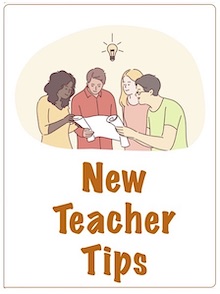3 Ways We Can Support Students Who Struggle
Dr. Curtis Chandler works with preservice and beginning educators to master the basics of effective teaching. Before joining a university faculty, he was a technology coach for a regional service agency and a Kansas state teacher of the year.
A MiddleWeb Blog

She stumbled sideways into the Fruit Loop section, crushing some of the cereal boxes and spilling a few more into the aisle. Calmly, the mother started picking up and rearranging, while the remaining siblings began to drift in different directions. The one who had tripped sat tying her shoe.
Her mother, now looking a little frazzled, gathered up her other ducklings and waited as patiently as she could for the determined little one to finish up with her laces. After several failed attempts, the mother reached down to tie it for her, only to have her child object loudly, ”I can do it myself!”
As educators, deciding when – and how much – to help our students can be difficult. It requires us to strike a delicate balance between maintaining high expectations and fully supporting our learners.
High Expectations for All
As educators we can have expectations of students that have a tremendous impact on their learning. As human beings we naturally formulate quick judgments of others with whom we come into contact. Teachers, however, run the risk of unwittingly setting inappropriate expectations of some students without taking into account a myriad of factors – past performance, family background, opportunity and more.
It’s important, therefore, that each of us take action to ensure that we are communicating confidence in all our students by:
- being knowledgeable about the potential impact of teacher expectations on student achievement and the risks of inequitable expectations;
- working to identify and amend negative attitudes about individuals and groups of students;
- engaging in regular self-assessment of the expectations we have for (and our interactions with) students.
In addition (and I know it can be challenging) teachers should identify or design tasks that move all students in the direction of developing the same knowledge and skills. On occasion, a need might exist for a student to be working toward a different or modified learning objective. For example…when specified in a student’s Individualized Education Plan (IEP). But, as often as possible, our goal should be to have all students working toward the same depth of learning as their peers.
Ways We Can Use Differentiation
The more we know about each of our students’ strengths and struggles, the better equipped we are to discern when and how to differentiate learning. Differentiation is NOT about creating a separate lesson or activity for each student, nor is about removing every barrier to learning.
Rather, differentiation is about making small but deliberate adjustments before/during a lesson in order to increase the likelihood of student success. Teachers can differentiate by content, process, and/or product. Let’s take a quick look at all three.
1. Differentiating the content
Differentiating the content refers to adjustments we make in the way that students access key information and skill-related knowledge.

Other ways to differentiate by content include offering a variety of materials that address the same information (i.e…text, audio, and video), providing supplemental materials to help clarify concepts, scaffolding difficult tasks, and chunking content in smaller, related pieces for students.
2. Differentiating the process
Differentiating the process refers to the way that we support students as they come to understand and make sense of new information and skills. We still teach the skill/concept to each student. However, the manner in which each student makes sense of the topic or skill – the process – can vary.

3. Differentiating the product
Educators can also differentiate the product – that is, the way in which learners demonstrate what they know and can do. As often as possible, teachers can provide struggling students with a choice between two assessment options that align to the same learning objective and success criteria.
For example, students could have product choices for a project (final paper, oral or graphic presentation) that appeal to different preferences. Learners could also be offered some choice of questions on quizzes and tests.
It is imperative for teachers to consider the students in their classrooms and how to best provide options that reflect choice, personal relevance to students’ lives, and an opportunity to transfer knowledge and skills into authentic and challenging tasks.
Planning for the Struggle
Designing effective learning experiences for students is time consuming and challenging. In addition, it seems that no matter how well designed (and differentiated) a lesson is, there will always be students who struggle.
The key is to plan ahead for both smooth student success and student struggle. Students don’t just need help…they need the right kind of help. When we look closely at our students and our learning tasks, we can anticipate and troubleshoot problems by maintaining high expectations and differentiating the content, process, and product of our lessons.



































